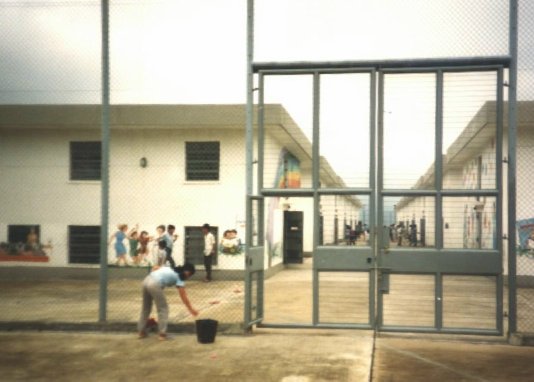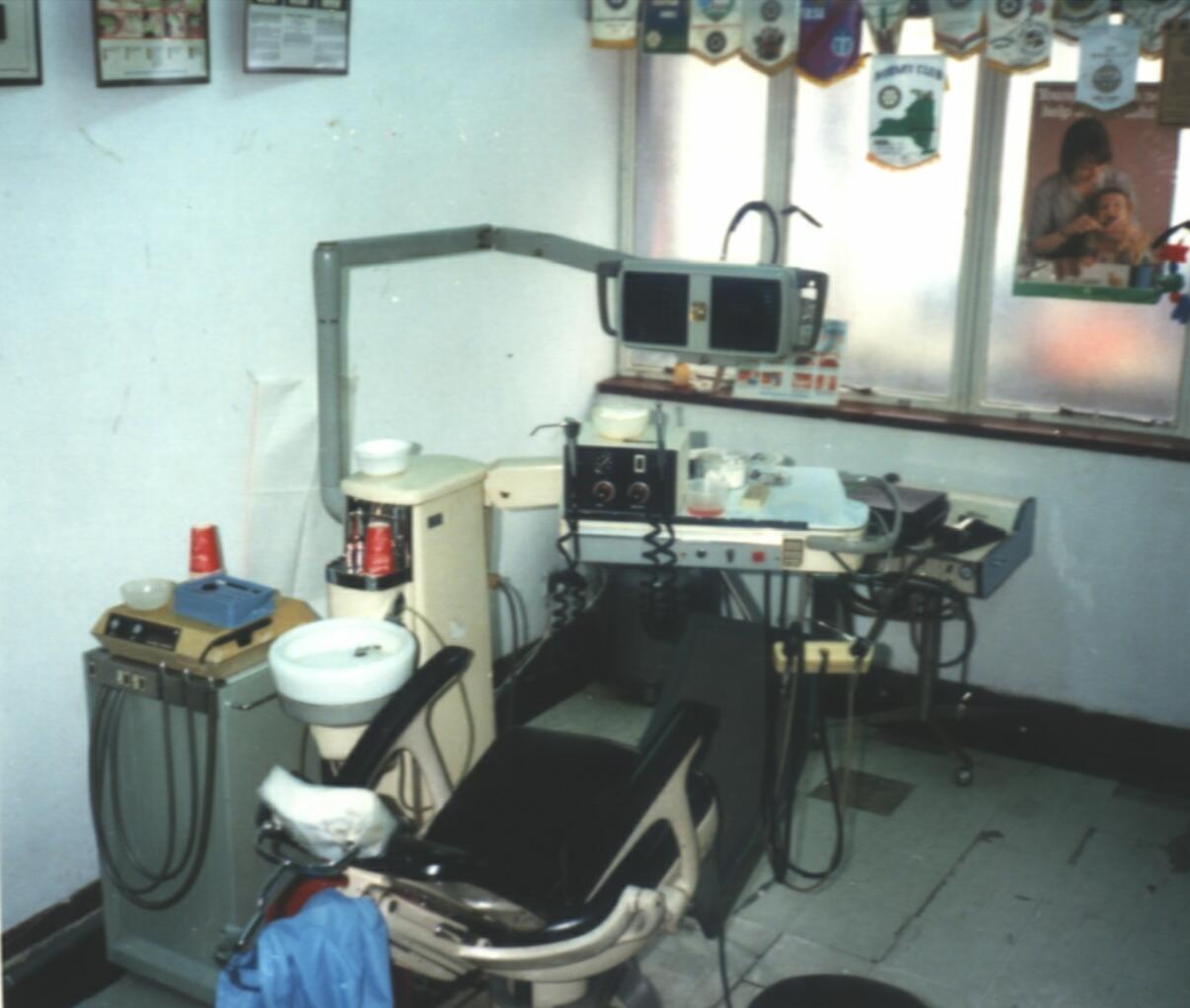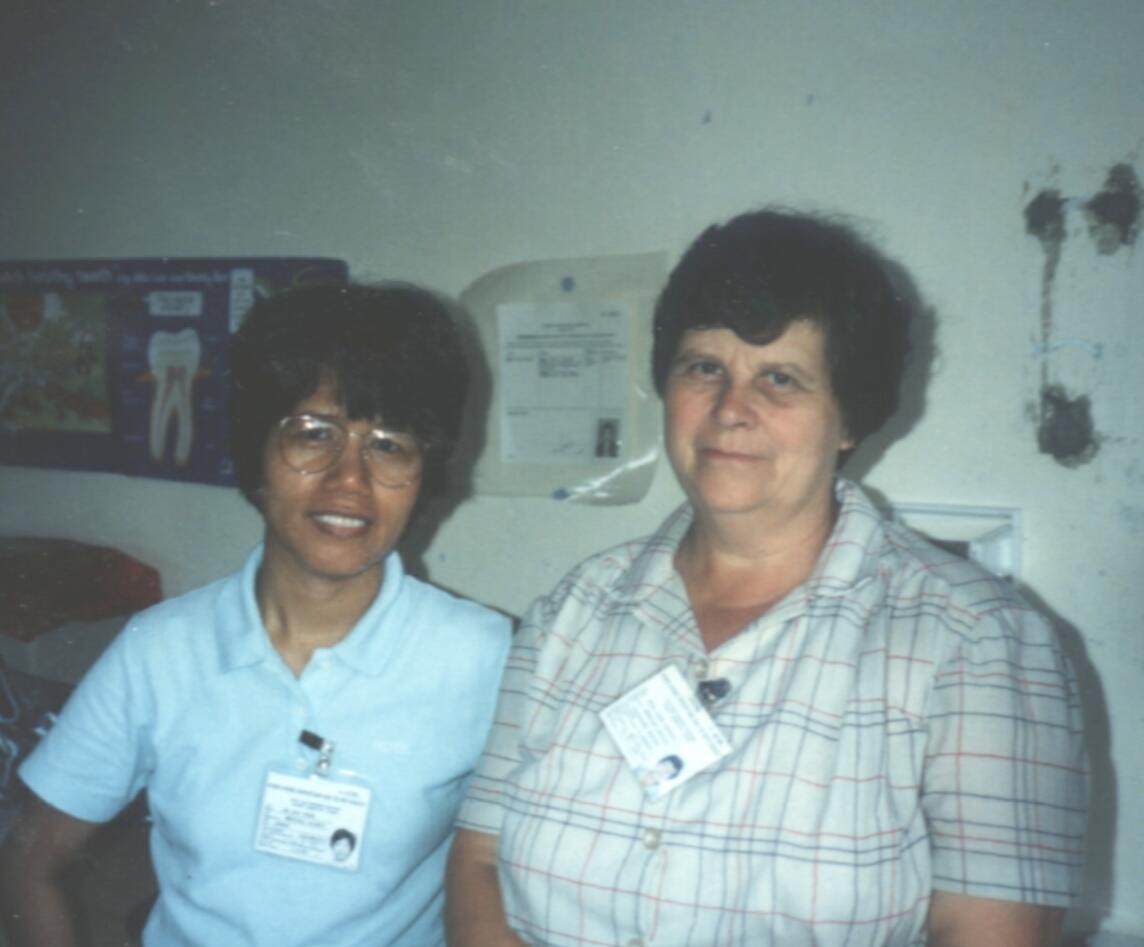|
Working with the Vietnamese Boat People |

Hei Ling Chau Refugee Camp. View from the surgery |
During the 1980's the
plight of the Vietnamese "Boat people" was widely publicised as the thousands of
people from Vietnam fled the political changes of their country and took to leaky
boats and ended up in Hong Kong, a place barely capable of dealing with the
invasion of desperate humanity. Harold Howard, Dentist and Club member, took a
keen interest and wanted to help. In 1986, encouraged by the current President, Ron Ebbett, he approached Rosalind Benford, Rotary Volunteer Co-ordinator for RI's
3H (Health, Hunger and Humanity) program. He was accepted as a volunteer, and in
1987, he and wife Jane, set out for Hong Kong. |
He and Jane were accommodated in the
Salisbury YMCA Hotel
and the Volunteer Dentist organisation based in the Kai Tak camp. The volunteer
scheme worked by rotating volunteer dentists every 4 weeks. Each day they would
set out for one of the four camps around Hong Kong. During the course of the week
Harold would visit each of the 4 camps. His schedule went as follows (with
variations)
-
Monday.
Travel by boat to the Hei Ling Chau Camp
-
Tuesday.
Taken by car to Kai Tak. From there to Argyle, then back for further work at Kai
Tak
-
Wednesday. Travel by boat to
the Chi Ma Wan camp.
-
Thursday.
Work at Kai Tak on patients brought in from Tan Man camp and more patients at Kai
Tak
-
Friday
Patients would be brought in from Argyle to Kai Tak.
|

Tran Van Thanh.
Harold shows him where Taradale is
on the Atlas he gave him. |
In a later report, Harold wrote-
"There are some 8,000 - 10,000 refugees distributed around the various open
and closed camps in Hong Kong, and although some of these people are placed each
year in new countries in the Western world, they are immediately replaced by
more refugees arriving from Vietnam. On reading very recent news reports it
would appear Hong Kong could expect a big increase of refugees. These are
Vietnamese refugees who have been resettled in mainland China and who believe
they can better their quality of life in the west.
|

Harold's surgery at the Kai Tak Camp |
I quote from the staff
reporter of a Hong Kong newspaper, " A HUMAN wave of more than 50,000 Vietnamese
refugees from China is poised to hit Hong Kong, the director of the United
Nations' High Commissioner for Refugees in Beijing warned yesterday." For the
foreseeable future there will be refugees in Hong Kong and their numbers will no
doubt increase. I therefore see an increased need for dental services. The
ageing dental equipment (especially in Kai Tak camp) which requires more
frequent maintenance and additions I believe should be replaced by new or near
new equipment. Roger Greene is the dental surgeon from the Prince Edward dental
school in Hong Kong, and his frequent attention and maintenance of this
equipment is understated and underestimated. It is given gratis and in his spare
time. Without him the visiting volunteer dentists would not be able to carry out
their duties as well as they would wish. " |
|

The monthly birthday party at Kai Tok |
Jane also involved herself
in the welfare of the refugees, particularly the children. In the same report, he
wrote-
"Jane (my wife) was able to help in the child
care centre at Kai Tak, where this service has some 100 preschool children on
the books. I understand these children are cared for from about 7.30 am till
5.00pm every working day - in most cases both parents being out at work during
the day. One person extra here to help was well accepted.
|

Jane with Hilda, Harold's assistant. |

Jane and Harold
depart the Chi Ma Wan Camp |
Jane also came out to the Chi Ma Wan closed
centre, to the "waiting room area" where quite a collection of people would
gather from the camp. Mrs Esther Lacey (Jane's predecessor) bought a jig
saw puzzle as did Jane for these people to try their hand at building. It was
also evident these people were very willing to try out their knowledge and usage
of the English Language. Although Jane
came only once to Hei Ling Chau closed camp there was not the same opportunity
to do what she did at Chi Ma Wan." |
|
By now it was very apparent
to Harold that the dental equipment was in need of upgrading. Much of it was of World War II vintage, and considering the work ahead there was an urgent need
to bring in new equipment. Harold continues-
"During our 4 weeks in Hong Kong it
was good to read a news report in the South China Morning Post 25.5.87. "Refugees
get better life in Camps". In Hei Ling Chau for example Refugees were earning up
to H.K.$60.00 day in small industries such as knitting. Other forms of
Vocational training are also being started. I was pleased to hear the Hong Kong
Rotary Clubs' approval of a grant of U.K.$23,310 for Dental Equipment. "
Dr Robert Lacey, President
of the Rotary Club of Binghamton, NY, raised with Harold the possibility of using Rotary International as a means of
upgrading the dental equipment in the surgeries. |
|

Dr Bob Lacey examines patient at the Argyll
Camp. The only light available is from the window. An interpreter stands by
if needed. |
"At this point I will report on discussions Bob
Lacey, my predecessor, and I had one week in, of my 4 week term of volunteer
dental duty. We both came to the conclusion that if we could enlist the interest
of all the Rotary Clubs whose respective dentist members who had served in Hong
Kong to contribute an amount of about U.S. $500.00 we would go a long way
towards funding the re-equipping of the surgeries in Hong Kong.
|
Now that my
Rotary Club banner is hanging in the surgery (clinic) at Kai Tak there are some
26 Rotary club banners, also there are some 50 dentists visiting cards under the
glass topped desk in the clinic at Kai Tak. This is an indicator of the number
of clubs to which we can make contact."

The Taradale Rotary Club banner hangs just
right of centre |

Rewi Alley, aged 89. Photo taken by Harold
Howard on his visit to him, 1st June 1989. |
Harold and Jane returned to New Zealand but not before a trip to China,
where Harold managed to get an appointment with the famous Kiwi, Rewi Alley,
who devoted a life time to humanitarian work for the Chinese. Harold was
given some help and a little local knowledge by Yick Gee, a
Past-President of the Taradale Rotary Club. Yick had written the address in
Chinese so Harold could give it to a taxi driver. Harold spent a wonderful hour
with the old man as they discussed many things about New Zealand, including
their common school of Christchurch Boys' High School. Rewi Alley died 6
months after the visit. |
|
|
The Matching Grant Project to Upgrade Dental
Equipment |
|
Back in New Zealand, Harold set
about enlisting the support of the Taradale Rotary Club in the project. Bob
Lacey took the role of costing the equipment and making the request to the
Rotary Foundation. The original estimate was for a project requiring $US9600
in funding. The sponsoring clubs were to be Binghamton and Taradale. Between
them, they were to put up $US1000. A successful matching grant request would
mean the Rotary Foundation would fund $US4800. This left $US3800 to be
raised from other Rotary Clubs.
For a matching grant, they
would need a local Club to take charge. Harold writes
"Dr Jorgen Theilade the Rotarian dentist member of
Hong Kong Rotary Club
and the President of the Hong Kong Rotary Club assured me their Rotary Club
would be behind any moves in the direction of new dental equipment and would
sponsor such a
project. This whole thought has the makings of being a
very good project in the International field which could involve sponsors from Bob Lacey's
predecessor's club
in Denmark, Bob Lacey's
club in Binghamton, the Hong Kong
Rotary Club, and my Taradale
Rotary Club in New Zealand. If this project also
qualified for a
special grant
subsidy then a very worthwhile fund could be used to re-equip
these Hong Kong refugee
Dental Clinics."
The drive for funds is taken
up by Bob Lacey in his report to Rotary Foundation and potential sponsors
"Our prime disappointment was the complete
absence of functioning sterilization equipment in any of the clinics.
Although boiler sterilizers were present, we considered these ineffective,
as was the cold sterilization methods, to properly protect our patients
and staff. We also found many instances which needed correcting:
1. At one clinic, if you raised the
dental chair, a short circuit occurred and all the equipment became
non-functional. Further, it took several minutes to repair and during this
time, the dentist could not accomplish any dental treatment.
2. To stand for several hours at a
dental chair is difficult and tiring for dentists. Comfortable seating for
the dentist was not available nor possible with the type of equipment
present.
3. The flooring was torn or missing
in the main clinic, making proper clinic cleanliness impossible.
4. The dental operating lights were
inadequate and antiquated. Indeed, services were performed at one clinic
which had no operating light and in front of a window.
5. Much of the treatment of Refugees
was concerned with gum problems caused by calculus (tartar) in huge
amounts. This calculus can be most effectively and quickly removed by
rather inexpensive ultrasonic equipment which was not available.
6. There are many other kinds of
equipment needed to improve the quantity and quality of service rendered
by these Volunteer dentists. With
the help and encouragement of Dr. Harold Howard (Taradale, New Zealand)
and Dr. Jorgen Hojerslev (Vedbaek, Denmark), who were my predecessor and
successor, I obtained the names of the dentists who proceeded us at the
Hong Kong Clinics.
These were
supplied by Rotary International Volunteer Coordinator, Roz Benford. The
Rotary Club of Hong Kong helped in coordinating the renovation effort.
Rotarian Dr. Jorgen Theilade (Professor at the Prince Philip Dental School
in Hong Kong) was appointed by them as liaison. He recruited a fine young
non-Rotarian dentist from the dental school. Dr. Roger Green, to do the
actual planning, buying and installing of the projected needed equipment.
A list was made and prices determined of the minimum needed equipment.
The price: $US9,600.00.
Letters soliciting contributions were
written to 36 dentists, who previously volunteered for duty at the Hong
Kong Dental Clinics. The Presidents of their respective Clubs, asking for
a donation to the project in their member's honour, were also written.
Three months later, in December of 1987, many of these dentists and their
Clubs had contributed. In January, I received a response from the "Special
Grants" Coordinator, Dianne Porter, of the Rotary foundation, saying that
if $4,800.00 could be raised, the Foundation would add $4,800.00 more.
However, we had only $4,200.00 and the prospects seemed rather gloomy. So,
another letter went out to the same people for contributions and stating
the progress to that date. Shortly thereafter, I heard from Dr. George
Ledger, former Volunteer from Taunton, Somerset, England saying that he
and his Club were running a "Shop" to benefit this project. Happily, on
March 10, the Taunton Rotary Club sent a check for 1250 pounds sterling
which put us way past the needed amount for the challenge "Special Grant"
and our goal of $US9,600.00.
Further response has brought us to a total (4 May 1988) of $US12,912.93
which has been forwarded to Dr. Greene in Hong Kong. Indeed, I hear
that many pieces of new equipment are already in place. I think another
exciting aspect of this project has been that 17 Clubs and individuals
responded with contributions. This should help rest the thought that
Rotarians are not merely a bunch of men and women who get together to eat
a meal once a week. All these Clubs and individuals have been written
letters of thanks, in the name of Rotary and the Refugees who will benefit
most from their contributions.
Some kind of an award will be made at the Philadelphia Rotary
International Convention. |
|
CONTRIBUTIONS TO THE HONG
KONG DENTAL CLINICS |
| |
CLUBS: |
$US |
|
| |
Colleens, Germany
|
400.00 |
|
| |
Watertown, Wisconsin
|
200.00 |
|
| |
Sollerod, Denmark
|
300.00 |
|
| |
Binghamton, New York
|
500.00 |
|
| |
Taradale, New Zealand
|
500.00 |
|
| |
Claremont, California
|
300.00 |
|
| |
Wiesbaden-Rheingau, Germany
|
400.00 |
|
| |
Columbia City, Indiana
|
100.00 |
|
| |
Omaha-Suburban, Nebraska
|
100.00 |
|
| |
Ellenburg, Washington
|
200.00 |
|
| |
Coventry North, England
|
200.00 |
|
| |
Taunton, Somerset, England
(Pounds Sterling) |
1,350.00 |
|
| |
INDIVIDUALS: |
|
|
| |
Dr. Joseph Fontana, New York |
200.00 |
|
| |
Dr. Robert Lacey, New York |
1,000.00 |
|
| |
Dr. Harold Howard, New
Zealand |
500.00 |
|
| |
Dr. John Mackenson,
Pennsylvania |
100.00 |
|
| |
Wray Stockton Monroe, North
Carolina |
700.00 |
|
| |
ROTARY INTERNATIONAL: |
|
|
| |
Rotary Foundation Special
Grant |
4,800.00 |
|
| |
TOTAL |
$12,912.93 |
|
|
|
Return to Hong Kong |
|
Harold return with Jane twice
more in 1989 and 1991 to do 4 week tours of duty in the refugee camps. One
of the great pleasures was to see the end result of the matching grant
project with the new equipment installed and already well used. Things
however had changed. He wrote some notes in relation to his experiences.
"Concerning the refugee problem, times
have changed since we were here in May-June 1987. Then only 8000-10,000
refugees from Vietnam existed. Today there are over 50,000.
Since June 1988 the government of Hong
Kong has changed its policy about the "boat people" as all who arrive
today would appear not to be political refugees but more economic. 8000
are expected in May 1989, 8000 in June, and 10,000 in July. All refugees
are now treated as illegal immigrants.
During 1987 we visited the Dental Clinics
in the camps once every week in the 4 week "stint". But today we visit
all camps about twice in four weeks. Many new camps have sprung up. In
July 1989, Shek Kong was built as a brand new camp in the New
Territories and it is soon expected to reach its limit of 7000 souls..
All inmates are living under canvas, and since it is a "closed camp", it
is surrounded by a high fence topped with barbed-wire."
In 1990 the Club honoured
Harold for his contribution to humanity with the Paul Harris medal |
|
|
